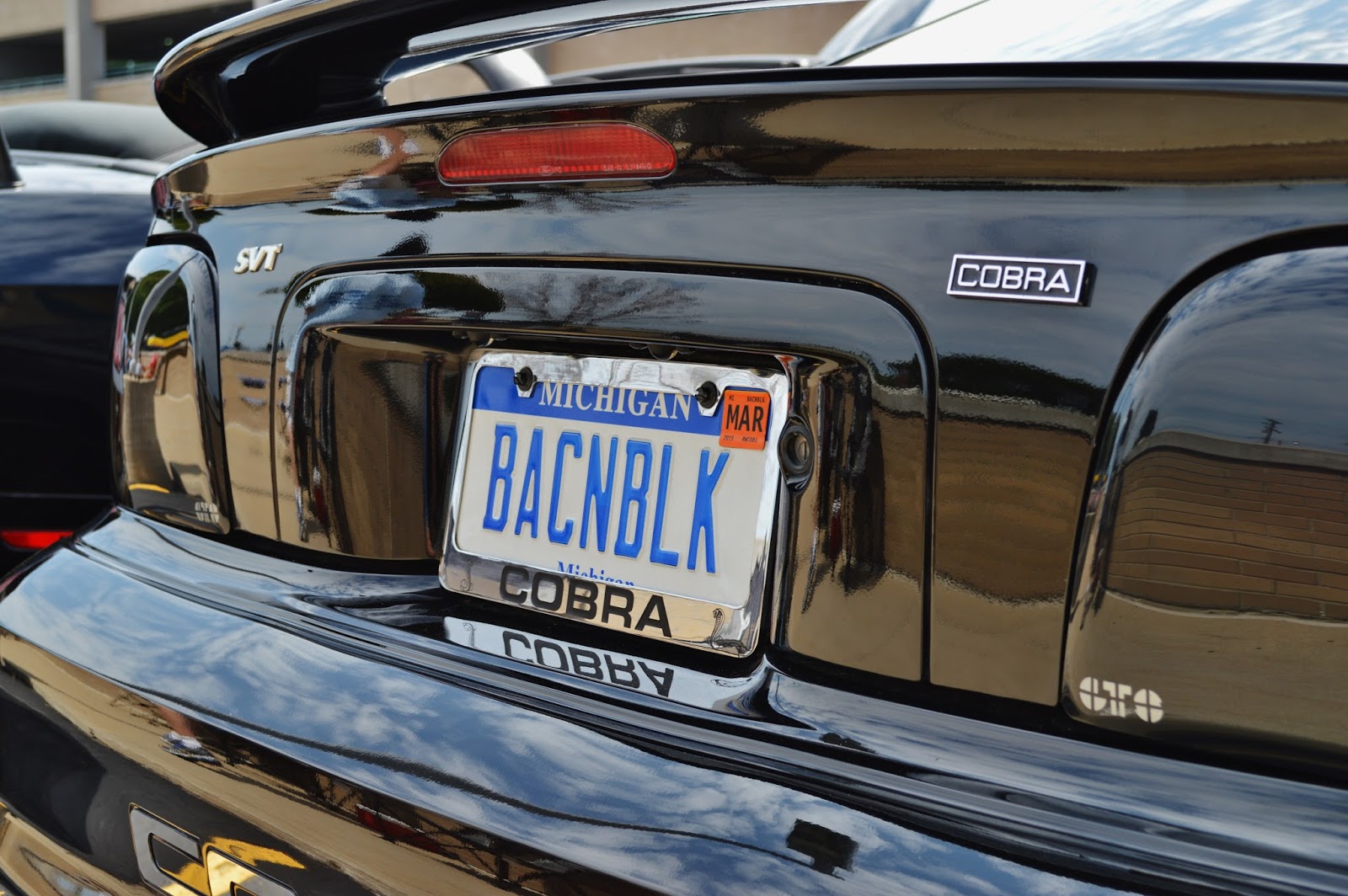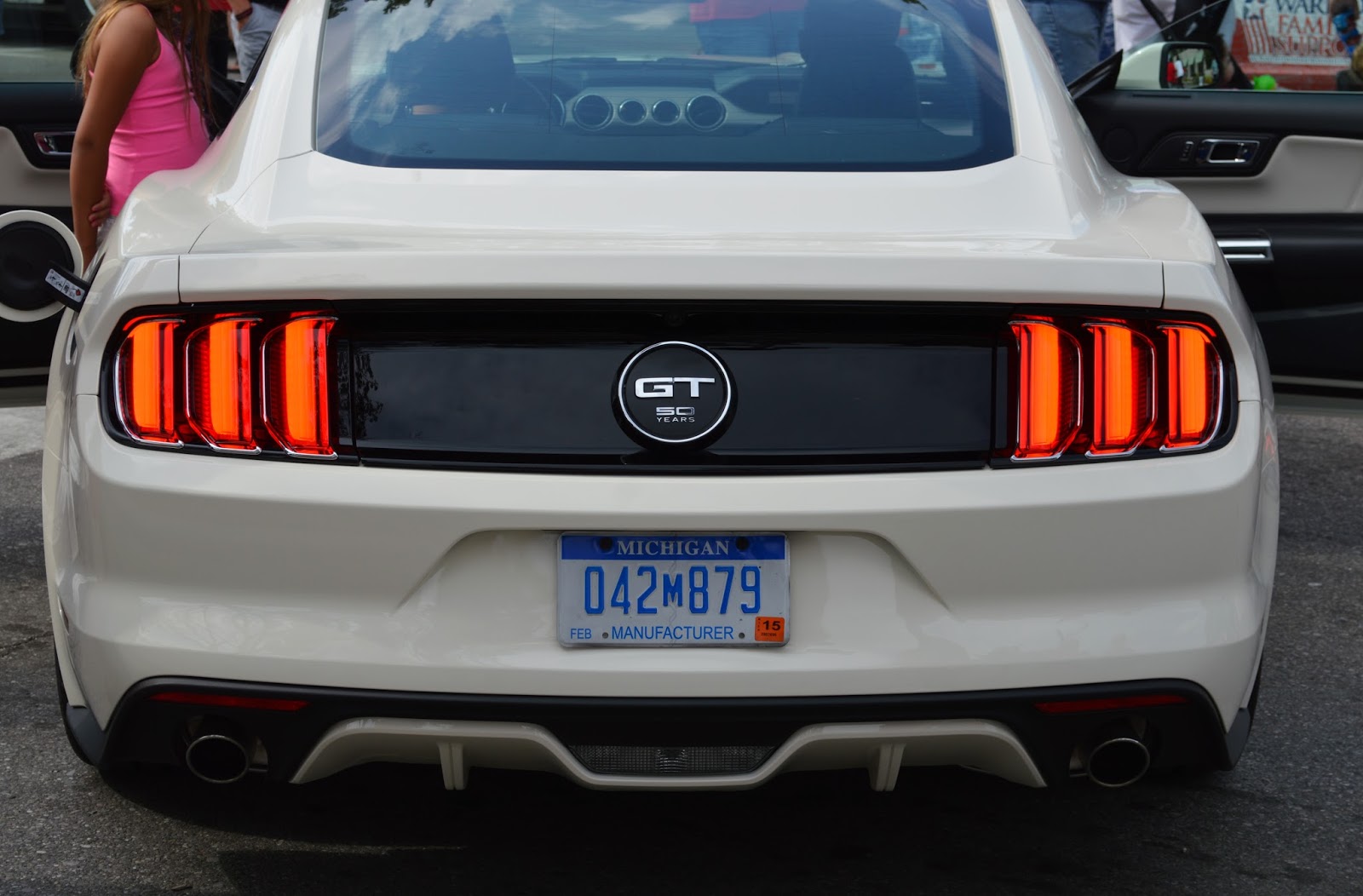I picked up Kevin and essentially drove more than twenty miles east on the very road that we live on. After several scenery changes and a few turns, we found ourselves in the volunteer parking garage and walked out into the "Snake Pit", a purely-Shelby and SVT vehicle display area in Mustang Alley.


'06 Shelby GT-H for Hertz, a revisit to the '66 GT350Hs that were part of the "Rent-a-Racer" program.
Also, an iridescent '04 Mystichrome colored Mustang Cobra.
As expected, I saw a bunch of very interesting and historically significant cars that I could go into detail about if I wanted. That won't be the focus of this post, though.
'95 Cobra with a 351 motor and the interior of a '65 Mustang.
'13 and '70 Boss 302s. Notice the identical stripes. The '12 and '69 Bosses also matched their stripe designs.
'67 Mustang drag car with a tunnel-rammed 390 V8 and one of many new 2015 Mustangs on display by Ford marketing.
The highlight of my day, though, began with a huge racket coming from one of the side streets. The lopey sound of the huge race cam was reminiscent of the '70 Boss 302 Mustangs that people like Parnelli Jones and George Follmer raced in the Trans Am series back in the day. As I ran over, I caught a glimpse of the Grabber Orange '70 Mustang and thought it might be one of those old race cars.
I walked closer to find that the car was unmarked, unlike a Boss 302. Unmarked, save for this legendary combination of letters and numbers.
At this point, I was in disbelief. If I could get starstruck about something, this was it. The Boss 429, often considered the meanest of the mean of production Mustangs, was produced in 1969 and 1970 and less than 1,500 were made in total. Originally, the Boss 429 was a NASCAR engine that was used in the Torino Talledegas. In order to qualify as a stock engine, Ford had to homologate them, or sell at least 500 to the public. Instead of selling street-going Boss 429 Torinos, Ford decided to shoehorn the engine into the Mustang. The engine was so big that another firm, Kar Kraft, was hired to move the shock towers out and spread the front wheels apart two inches. The "Yeah, it's got a Hemi" sticker above is usually purchased for Chrysler's Hemi cars but the Boss 429 did use cylinder heads with hemispherical combustion chambers, making this a true hemi as well. Many people at the show were caught off guard with that.
So this guy, Keith, is the second owner of the car. He bought it in 1978 after the original owner had already beat the car up and enjoyed it thoroughly. According to Keith, the first owner did all sorts of illegal things with the Boss but the police was never able to catch him. They finally nabbed him for having tires sticking too far out of the wheel wells. It was a legitimate safety hazard as the tires would throw pebbles and things at people, so the strange fender flares were added. It was rough when Keith received it and the second-best part of it all is that he has not even restored it after all these years.
We started talking more in-depth since I understood and he even took out two sets of old dry-deck head gaskets that he had to replace. "How many miles are on it?" "A LOT." Throughout the day, I would hear Keith periodically turning it on when people asked, revving it to 7500 rpm and stabbing the throttle a few more times. You might think it's uncharacteristic for an old school, pushrod, big block engine to be able to safely spin that fast, but after all, it is a NASCAR motor and it was designed to sit at 7000+ all day long.
Here's the best part of the story: Keith does not drive this car softly. He feels lucky that it is not a $500,000+ garage queen, as almost all surviving Boss 429s are today. He's able to take full advantage of this car's brute force and drives the piss out of it every chance he gets. I love the rubber bits that have been blasted onto the quarter panel. Notice the exhaust cutouts. When the flaps are open, the mufflers are bypassed and the engine can breathe more efficiently and more loudly.
I love this car, the owner, and the story. Despite the strange fender flares, this is probably my favorite Mustang out of all the ones I've seen in my life. For its whole life, the Boss has been thoroughly enjoyed and thrashed, doing what it was built to do. It's nice enough to leave unrestored but rough enough that it can be chucked over a dirt road.
TL;DR - Man continues to drive a super rare, super powerful Mustang like a madman after almost forty years of ownership.
To put that in perspective, this has been my dream car for a long time now: a Grabber Orange 1969 Mustang fastback with a 428 FE engine, set up for street driving and casual drag racing. The 1969 and '70 Mustangs shared the same body style but the 428 and 429 engines are completely different. I am also going to enjoy the car thoroughly once I finally buy it and get it running.
Some shots of the cruise after our shift was over:
A '69 Mustang racer on a trailer similar to the Trans Am Bosses I mentioned earlier, not sure if it was originally a race car. Also, a '64 Ford Galaxie, which in this color is pretty high on my want list.
A '70s Ford Country Squire wagon, likely with the 460 c.i, (7.5 L) big block V8. Next, a "1920 Dodge Brothers" roadster sitting awkwardly on a new truck frame with a 350 Chevy V8.
A bonus: Kevin and I each got a 1:64 (Hot wheels size) die cast of the new Mustang for free after registering for free for a raffle that seemed like it had no strings attached. It's super detailed and has rubber tires. It is made by Maisto and although its quality has plummeted in the recent years, these models are extremely well-made.





















No comments:
Post a Comment